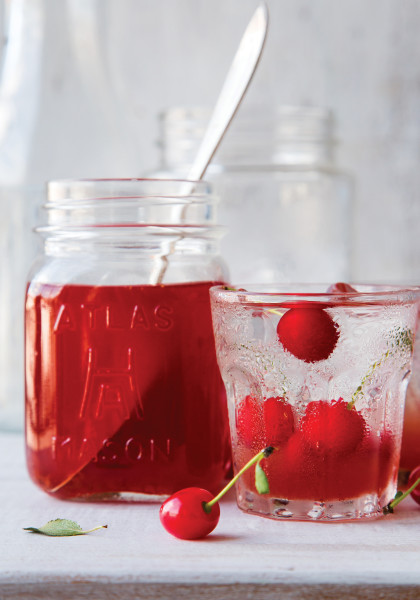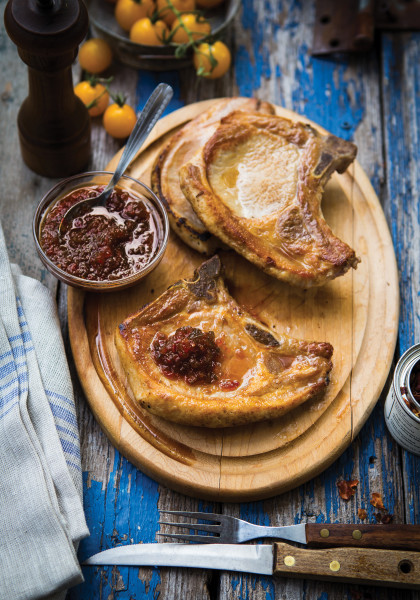
Title: Preservation Society Home Preserves: 100 Modern Recipes
Author: Camilla Wynne
Published by Robert Rose, April 2015
Paperback, suggested retail $24.95 US
192 pages, 7″ x 10″ book with 60 color photographs
ISBN: 978-0-7788-0503-8
As I have gotten older, I have started to enjoy home canning. It was a bit intimidating at first, but so rewarding. It gives you another outlet to control what goes into the food you eat and is quite cost-effective.
The Preservation Society is a small batch preserves company out of Montreal, Canada. The author, Camilla Wynne, is also the founder of the company. She is also one of Canada’s only Master Preservers.
In Preservation Society Home Preserves, Camilla creates unique and sumptuous preserves for you to enjoy. The recipes are creative and modern so don’t be surprised that this book varies quite a bit from any canning books you might have gotten handed down from your grandmother. This book teaches you how to make Cajun Pickled Eggs, Isaac’s Breakfast Bacon Jam, or Jam Pockets, which remind me of commercially available Pop Tarts, plus much more.
Here are some great recipes to try and sample from Preservation Society Home Preserves featured below. Enjoy!
Courtesy of Preservation Society Home Preserves by Camilla Wynne, 2015 © www.robertrose.ca Reprinted with publisher permission. Available where books are sold.

Pina Colada Jam, page 34, jams
PIÑA COLADA JAM
THIS DELICIOUS JAM SPEAKS FOR ITSELF. It’s got all the flavors of the classic cocktail, but is socially acceptable to eat for breakfast. The chunky texture, full of chewy coconut, also makes it a pretty choice for a dessert component — on ice cream, between cake layers, stirred into mascarpone … the list goes on.
2.9 lbs pineapple flesh (from 2 pineapples) 1.3 kg
21⁄2 cups jam (gelling) sugar 500 g
12⁄3 cups unsweetened flaked coconut 100 g
Grated zest and juice of 2 limes
6 tbsp dark rum, divided 90 mL
Chop the pineapple into fairly small dice.
In a large pot or preserving pan, combine the pineapple, sugar, coconut, lime zest and juice and about half the rum. Cover and let stand to macerate for 30 minutes.
In the meantime, prepare the jars and lids.
Bring the pineapple mixture to a boil over medium-high heat, stirring often. Boil hard, stirring often, until the setting point is reached (see page 17). Remove from heat and let rest for 5 minutes, stirring occasionally. Stir in the remaining rum.
Ladle jam into the hot jars to within 1⁄4 inch (0.5 cm) of the rim. Remove any air bubbles and wipe rims. Place the lids on the jars and screw the bands on until fingertip-tight. Process in a boiling water canner for 10 minutes.
MAKES ABOUT FIVE JARS (8 OZ/250 ML EACH)

Sour Cherry Lemonade Concentrate, page 96, syrups
SOUR CHERRY LEMONADE CONCENTRATE
THIS SYRUP IS A BOON TO HAVE ON HAND in the pantry on a hot summer’s day. If you’re on your own, add a few tablespoons to a glass of ice water, then refrigerate the rest for the next time you get thirsty. If you’re serving a crowd, pour the whole jar into a big pitcher and dilute to taste. For a grownups-only party, add gin or vodka for a very easy, very drinkable cocktail.
1 lb pitted sour cherries 450 g
3 cups granulated sugar 600 g
Pinch salt
Grated zest of 5 lemons, divided
2 cups water 500 mL
11⁄2 cups freshly squeezed lemon juice 375 mL
Prepare the jars and lids.
In a large pot, combine the cherries, sugar, salt, zest of 3 lemons and water. Bring to a boil over medium-high heat, stirring to dissolve the sugar. Reduce the heat and simmer gently, stirring occasionally, for about 15 minutes to coerce the cherries into letting all their juice flow.
Pour the cherry mixture into a fine-mesh sieve set over a deep container. Push down against the cherries to extract as much liquid as possible. Stir the remaining lemon zest and the lemon juice into the syrup.
Pour syrup into the hot jars to within 1⁄2 inch (1 cm) of the rim. Wipe rims. Place the lids on the jars and screw the bands on until fingertip-tight. Process in a boiling water canner for 15 minutes.
MAKES ABOUT THREE JARS (1 PINT/500 ML EACH)
TIPS
If you don’t have a kitchen scale, you’ll need 3 cups (750 mL) pitted sour cherries for this recipe.
For 11⁄2 cups (375 mL) lemon juice, you’ll need 8 or 9 lemons.

Jalapeño Jam, page 138, chutneys, relishes & savory jams
JALAPEÑO JAM
I LOVE PEPPER JELLY, a Southern staple frequently paired with cream cheese and crackers, but I’d never made it myself. Every time I saw a jar, I’d buy or trade for it, but every recipe I’d ever seen used pectin. My gustatory feelings about pectin aside, I’m just not very good at using it — often I can’t get the right set, even when I follow instructions to a tee. (Maybe pectin is punishing me?) Finally, though, a client asked whether I could make some pepper jam, so I started experimenting with natural pectin boosters. First, I threw in a few apples, and then I saw a very old recipe in a vintage Time Life preserving book that used quartered lemons. Bingo! The result isn’t quite the same as the pepper jellies you might know — it’s a little looser, a little chunkier — but it’s absolutely incredible with cream cheese and crackers. And biscuits, too!
2 lemons, quartered 2
1.2 lbs apples (3 to 4 medium), finely chopped 540 g
12 oz red bell peppers 350 g (2 medium), finely chopped
12 oz jalapeÒo peppers (about 350 g 12 medium), seeded and finely chopped
1 tsp kosher or pickling salt 5 mL
3 cups granulated sugar 600 g
3 cups cider vinegar 750 mL
Prepare the jars and lids.
In a large pot, combine the lemons, apples, red peppers, jalapeños, salt, sugar and vinegar. Bring to a boil over medium-high heat. Reduce heat and simmer, stirring often and reducing the heat as necessary, until thick. Remove from heat and fish out the lemons, which will now just be soft pieces of peel; discard lemons.
Ladle jam into the hot jars to within 1⁄4 inch (0.5 cm) of the rim. Remove any air bubbles and wipe rims. Place the lids on the jars and screw the bands on until fingertip-tight. Process in a boiling water canner for 10 minutes.
MAKES ABOUT FOUR JARS (8 OZ/250 ML EACH)
TIPS
I find it easiest to use a food processor to chop the apples, red peppers and jalapeños — just make sure not to chop them too finely!
I highly recommend you wear plastic gloves to handle the jalapeños; otherwise, you’ll be sorry.
Disclosure: I received a copy of this book to review. No other compensation was received for this post.

